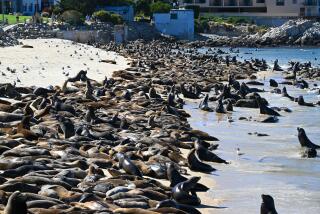Oxnard Least Terns: Making the Most of a Bad Situation : Environment: The endangered birds are making a comeback at Ormond Beach, but the largest colony has been driven out of Point Mugu.
OXNARD â Least terns are making a comeback in Oxnard, but nature has driven the stateâs largest colony of the endangered birds from Point Mugu.
At Oxnardâs Ormond Beach, the birds have overcome the problems of pests, people and three-wheeled motorbikes, producing 15 healthy chicks since May.
It is a notable achievement for the birds, which are an endangered species. For years, five pairs that lived at Ormond Beach saw their nests destroyed by people, other birds, varmints and dogs.
This year, a larger colony of the terns has driven away intruders, and stepped-up police patrols have held down damage by illegal three-wheelers.
Happiness about the comeback, however, has been offset by disappointment over the loss of the colony at Point Mugu, just to the southeast. Biologists say some of the Ormond birds may be refugees from Mugu.
At Point Mugu, the Navy kept the public away from the ternsâ nesting area. Last summer, more than 100 pairs nested there.
But in May, as young terns found their lifetime mates and began to settle onto the sand to lay eggs, a storm sent waves crashing over the beach. It crushed eggs and washed out nests. Predators ate the remaining eggs.
Soon after the storm, the adult birds abandoned the colony, said Grace Smith, a Point Mugu Navy biologist.
âItâs so sad,â she said. âThis year we have none.â
Some of the birds will probably return next year, biologists say.
The least terns are the smallest of the North American terns. White with black masks, they have nine-inch bodies and a 20-inch wingspan. Their high-pitched call is more like a loud squeak than a song. It changes to a strong âkick-kick-kick-kickâ when they are alarmed. They feed on marine life.
The birds winter in South America and return to Southern California in April to mate, nest and form colonies. Both male and female protect the nest, taking turns at mealtime.
Two days after the young emerge, the wobbly chicks make their way out of the shallow nests to protected areas behind dunes. Their parents support them for another five weeks.
The colonies are frequently invaded by gulls that blunder through or come looking for eggs. They are greeted by dive-bombing terns, which deposit splats of white waste on their heads.
The birds once numbered in the thousands, nesting from San Francisco to San Diego. As development encroached on beaches, least terns statewide dwindled to about 300 pairs by the early 1970s.
Now their status as an endangered species provides some protection of habitat. The state population has grown to about 1,000 pairs, U.S. Fish and Wildlife Service biologist Martin Kinney said from his office in Laguna Niguel.
A similar subspecies exists along the Mississippi River and on the East Coast, but the California least terns are the only ones of their particular subspecies in the world.
âWith all the development in Southern California, once a colony is destroyed, there is no new habitat being created,â Kinney said. âThe remaining colonies have to be protected if weâre ever going to get the bird to a level where it can recover.â
Kinney said that is difficult with only 15 wildlife officers from Ventura to the Mexican border.
In Ventura, Fish and Wildlife Service biologist Scott Johnston, whose area stretches from Pismo Beach to Ventura, agreed and complimented citizen advocates of the birds.
âI need all the help I can get,â Johnston said. âThe local help has been absolutely critical to recovering the birds here.â
More to Read
Sign up for Essential California
The most important California stories and recommendations in your inbox every morning.
You may occasionally receive promotional content from the Los Angeles Times.










